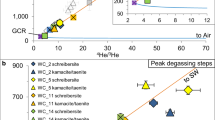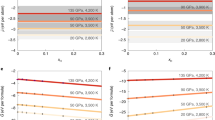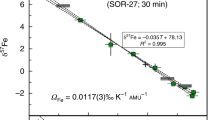Abstract
The hypothesis that 40K may be a significant radioactive heat source in the Earth's core was proposed on theoretical grounds1,2 over three decades ago, but experiments3,4,5,6,7,8 have provided only ambiguous and contradictory evidence for the solubility of potassium in iron-rich alloys. The existence of such radioactive heat in the core would have important implications for our understanding of the thermal evolution of the Earth and global processes such as the generation of the geomagnetic field, the core–mantle boundary heat flux and the time of formation of the inner core9,10,11,12. Here we provide experimental evidence to show that the ambiguous results obtained from earlier experiments are probably due to previously unrecognized experimental and analytical difficulties. The high-pressure, high-temperature data presented here show conclusively that potassium enters iron sulphide melts in a strongly temperature-dependent fashion and that 40K can serve as a substantial heat source in the cores of the Earth and Mars.
This is a preview of subscription content, access via your institution
Access options
Subscribe to this journal
Receive 51 print issues and online access
$199.00 per year
only $3.90 per issue
Buy this article
- Purchase on Springer Link
- Instant access to full article PDF
Prices may be subject to local taxes which are calculated during checkout




Similar content being viewed by others
References
Lewis, J. S. Consequences of the presence of sulfur in the core of the Earth. Earth Planet. Sci. Lett. 11, 130–134 (1971)
Hall, H. T. & Murthy, V. R. The early chemical history of the Earth: some critical elemental fractionations. Earth Planet. Sci. Lett. 11, 239–244 (1971)
Oversby, V. M. & Ringwood, A. E. Potassium distribution between metal and silicate and its bearing on the occurrence of potassium in the Earth's core. Earth Planet. Sci. Lett. 14, 345–347 (1972)
Goettel, K. A. Partitioning of potassium between silicates and sulphide melts: experiments relevant to the Earth's core. Phys. Earth Planet. Inter. 6, 161–166 (1972)
Murrell, M. T. & Burnett, D. S. Partitioning of K, U, and Th between sulfide and silicate liquids: Implications for radioactive heating of planetary cores. J. Geophys. Res. 91, 8126–8136 (1986)
Chabot, N. L. & Drake, M. J. Potassium solubility in metal: the effects of composition at 15 kbar and 1900 °C on partitioning between iron alloys and silicate melts. Earth Planet. Sci. Lett. 172, 323–335 (1999)
Gessmann, C. K. & Wood, B. J. Potassium in the Earth's core? Earth Planet. Sci. Lett. 200, 63–78 (2002)
Ohtani, E., Yurimoto, H. & Seto, S. Element partitioning between metallic liquid, silicate liquid, and lower-mantle minerals: implications for core formation of the Earth. Phys. Earth Planet. Inter. 100, 97–114 (1997)
Gubbins, D., Masters, T. G. & Jacobs, J. A. Thermal evolution of the Earth's core. Geophys. J. R. Astron. Soc. 59, 57–99 (1979)
Buffett, B. A., Huppert, H. E., Lister, J. R. & Woods, A. W. On the thermal evolution of the Earth's core. J. Geophys. Res. 101, 7989–8006 (1996)
Labrosse, S., Poirier, J.-P. & Le Mouel, J.-L. The age of the inner core. Earth Planet. Sci. Lett. 190, 111–123 (2001)
Stevenson, D. J., Spohn, T. & Schubert, G. Magnetism and thermal evolution of the terrestrial planets. Icarus 54, 466–489 (1983)
Walter, M. J. & Thibault, Y. Partitioning of tungsten and molybdenum between metallic liquid and silicate melt. Science 270, 1186–1189 (1995)
Jana, D. & Walker, D. The influence of silicate melt composition on distribution of siderophile elements among metal and silicate liquids. Earth Planet. Sci. Lett. 150, 463–472 (1997)
Righter, K., Drake, M. J. & Yaxley, G. Prediction of siderophile element metal/silicate partition coefficients to 20 GPa and 2800 °C: the effects of pressure, temperature, oxygen fugacity, and silicate and metallic melt composition. Phys. Earth Planet. Inter. 100, 115–134 (1997)
Righter, K. & Drake, M. J. Metal/silicate equilibrium in a homogeneously accreting Earth: New results for Re. Earth Planet. Sci. Lett. 146, 541–554 (1997)
Gessmann, C. K. & Rubie, D. C. The origin of the depletions of V, Cr and Mn in the mantles of the Earth and Moon. Earth Planet. Sci. Lett. 184, 95–107 (2000)
Li, J. & Agee, C. B. The effect of pressure, temperature, oxygen fugacity and composition on partitioning of nickel and cobalt between liquid Fe-Ni-S alloy and liquid silicate: Implications for the Earth's core formation. Geochim. Cosmochim. Acta 65, 1821–1832 (2001)
Hillgren, V. J., Gessmann, C. K. & Li, J. in Origin of the Earth and Moon (eds Canup, R. M. & Righter, K.) 245–263 (Univ. Arizona Press, Tucson, 2000)
Holzheid, A. & Grove, T. L. Sulfur saturation limits in silicate melts and their implications for core formation scenarios for terrestrial planets. Am. Mineral. 87, 227–237 (2002)
McDonough, W. F. & Sun, S.-S. The composition of the Earth. Chem. Geol. 120, 223–253 (1995)
Buffett, B. A. Estimates of heat flow in the deep mantle based on the power requirements for the geodynamo. Geophys. Res. Lett. 29, doi:10.1029/2001GL014649 (2002)
McKenzie, D. & Richter, F. M. Parameterized thermal convection in a layered region and the thermal history of the Earth. J. Geophys. Res. 86, 11667–11680 (1981)
Bertka, C. M. & Fei, Y. Implications of Mars Pathfinder data for the accretion history of the terrestrial planets. Science 281, 1838–1840 (1998)
Fei, Y., Li, J., Bertka, C. M. & Prewitt, C. T. Structure type and bulk modulus of Fe3S, a new iron-sulfur compound. Am. Mineral. 85, 1830–1833 (2000)
Lodders, K. & Fegley, B. An oxygen isotope model for the composition of Mars. Icarus 126, 373–394 (1997)
Acuña, M. H. et al. Global distribution of crustal magnetization discovered by the Mars Global Surveyor MAG/ER experiment. Science 284, 790–793 (1999)
Stevenson, D. J. Mars core and magnetism. Nature 412, 214–219 (2001)
Nimmo, F. & Stevenson, D. J. The influence of early plate tectonics on the thermal evolution and magnetic field of Mars. J. Geophys. Res. 105, 11969–11979 (2000)
Acknowledgements
We thank M. Drake and D. Draper for comments and suggestions, N. Irvine for providing the K-silicate glass, B. Mysen for advice on silicate melt properties, C. Hadidiacos for assistance in electron microprobe analyses and C. Alexander, R. Carlson, E. Hauri, J. Li, F. Nimmo, D. Stevenson and J. Van Orman for discussions. This work was supported by a Grant-in-aid from the University of Minnesota (V.R.M.), the NASA (Y.F.), a Carnegie Institution Postdoctoral Fellowship and the Swiss National Science Foundation (W.v.W.).
Author information
Authors and Affiliations
Corresponding author
Ethics declarations
Competing interests
The authors declare that they have no competing financial interests.
Supplementary information
41586_2003_BFnature01560_MOESM1_ESM.pdf
Supplementary Information: In this supplementary section we provide further analytical details and high resolution images of a typical run product. (PDF 131 kb)
Rights and permissions
About this article
Cite this article
Murthy, V., van Westrenen, W. & Fei, Y. Experimental evidence that potassium is a substantial radioactive heat source in planetary cores. Nature 423, 163–165 (2003). https://doi.org/10.1038/nature01560
Received:
Accepted:
Issue Date:
DOI: https://doi.org/10.1038/nature01560
This article is cited by
-
The Geochemical Legacy of Low-Temperature, Percolation-Driven Core Formation in Planetesimals
Earth, Moon, and Planets (2023)
-
Geoneutrinos and geoscience: an intriguing joint-venture
La Rivista del Nuovo Cimento (2022)
-
Electrical and thermal conductivity of Earth’s core and its thermal evolution—A review
Acta Geochimica (2022)
-
Pre-mission InSights on the Interior of Mars
Space Science Reviews (2019)
-
Depletion of potassium and sodium in mantles of Mars, Moon and Vesta by core formation
Scientific Reports (2018)
Comments
By submitting a comment you agree to abide by our Terms and Community Guidelines. If you find something abusive or that does not comply with our terms or guidelines please flag it as inappropriate.



